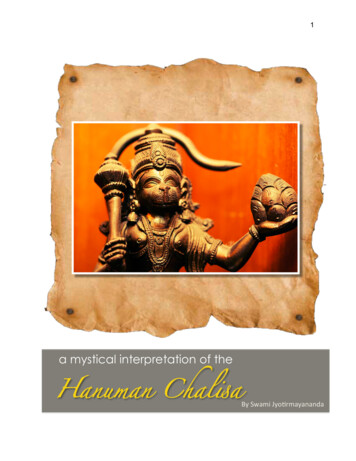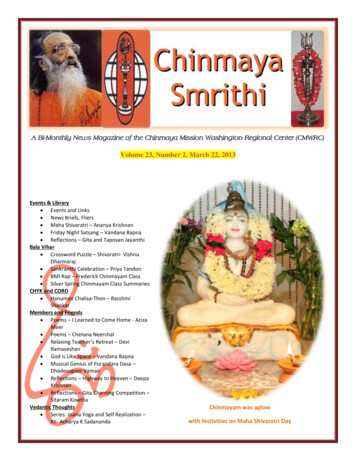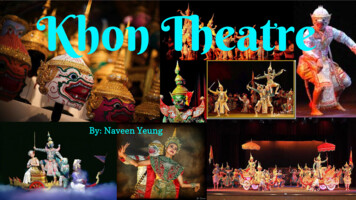
Transcription
1a mystical interpretation of theHanuman Chal!aBy#Swami#Jyo rmayananda#
2A Mystical Interpretation of the Hanuman ChalisaBy Swami JyotirmayanandaIntroduction by Ram-GiriThe Ramayana is one of the greatest stories ever told. In this fantastic tale of theadventures of Gods and demons, humans, monkeys and bears, the fertile mind of Indiatakes us into a journey to our own liberation.The tale engrosses the heart and mind because it is infinitely deeper than its surfacenarrative. It is a story told by the enlightened mind to enlighten us. It gives us a masterkey, a highly sophisticated psychology of the Higher Self, which transforms the readeron levels much deeper than the thinking mind.Here is a simplified summary of the mystical significance of the major elements of theRamayana, following Swami Jyotirmayananda’s fascinating interpretation. The wholestory is told with fascinating detail in Swamiji’s “Mysticism of the Ramayana,” availableat yrf.org.Rama symbolizes the Supreme Self, the Ultimate Reality, the Brahman of theUpanishads. His brothers stand for sat-chit-ananda, the divine attributes—existence,consciousness, and bliss. Sita is the Divine Mother, who, through the Cosmic Mind, isthe cause of the multiplicity of life. She is inseparable from Brahman.On the level of our relative existence the protagonists represent the aspects of our lives:Rama stands for the soul in the process of awakening. Lakshmana is the power of willin us. Shatrughna represents reason, and Bharata is the emotional aspect of thepersonality, which is channeled into devotion. Sita is the intellect (buddhi) that finds itsdivine origin.King Dasharatha stands for the human personality. His three queens are the positiveaspects of the three gunas (modes of nature): Kausaliya is Sattva (harmony, balance,light and intelligence; our higher spiritual potential), Sumitra is Rajas (the power ofaction, energy, movement and change), and Kaikeyi is Tamas (darkness, inertia,dullness, unconsciousness).Rama—the soul—breaks Shiva’s bow, which is symbolic of breaking the spell of ego,the spell of ignorance, and of embarking on the spiritual quest. This wins him the handof Sita, which means the higher, spiritual intelligence (buddhi) comes alive in us, leadingus to enlightenment.But Sita, the intellect, is kidnapped by the demonic force (Ravana—avidia or ignorance)and imprisoned in Lanka, the depth of the unconscious mind. In order to find her andfree her, Rama meets sages and saints (seeks satsang or spiritual company). He
3befriends monkeys and bears, which means the soul integrates the energies of thesenses. Then he sends Hanuman (the sadhana shakti, power of spiritual practice) tofind Sita. Hanuman burns Lanka (he overhauls the unconscious) and brings the news ofSita to Rama. This means the soul and higher intelligence are connected throughinsight into the practice of meditation and Samadhi.Rama then builds a bridge across the ocean to Lanka. This bridge is the mysticalconnection into the unconscious, built with the rocks of shubha samskaras (pureimpressions, the cultivation of a pure mind). Rama, the soul, then enters the kingdom ofthe demons (the recesses of the unconscious mind where the roots of ignorance,egoism and evil dwell).The demon brothers Ravana, Kumbhakarna and Vibhishana, represent the negativeaspects of the three gunas that keep the soul in bondage. Vibhishana is sattva, Ravanais rajas, and Kumbhakarna is Tamas. Vibhishana switches allegiance to Rama, whichallows Rama to destroy the demons. In this way the soul, after developing sattva, isable to overcome the power of the rajasic and tamasic forces. In this process the light ofthe soul dissolves the darkness of the unconscious and allows the unconscious to beruled by sattva. When the war has come to an end, Rama installs Vibhishana to be theruler of Lanka.Rama is then reunited with Sita, after she undergoes the fire ordeal. This means thatthe soul and buddhi (the higher mind) are joined, after has been purified in the fire ofspiritual practice and becomes intuitive. Rama and Sita (the union of soul and pureintellect) then return to Ayodya and establish Rama Rajya on earth, a life of divine glory,free of fear and suffering, which symbolizes jivan mukti, the state of enlightenment. Hanuman, the monkey God, is a central hero of the Ramayana. Widely worshipped inIndia, he represents the faith that can move mountains. His fame is extolled in theHanuman Chalisa, a song of 40 verses.
4Hanuman Stuti(Adorations to Lord Hanuman)Atulita bala-dhaamam hema-shailaabha-deham,Danuja-vana-krishaanum jnaaninaam-agraganyam.Sakala-guna-nidhaanam vaanaraanaamadheeshamRaghupati-priya-bhaktam vaata-jaatam namaami.I offer adorations to Lord Hanuman, who is the very abode of strength, whosebody shines like the Golden Mountain (Mt. Sumeru), who is like fire forconsuming the forest of the demons (forces of darkness), the foremost among thewise, the abode of all divine qualities, the ruler of all monkeys (the mind andsenses), the dearest devotee of Lord Rama, the son of the Wind God!Sita-raama guba-graama punya-aranya vihaarinau.Vande vishuddha vijnaanau kaveeshara kapeeshwarau.Adorations to Sri Hanuman, the lord of monkeys, the lord of Divine poets, the veryembodiment of pure wisdom, who delightfully sports in the forests of the Divineglories of Sita and Rama!—Om Sri Hanumate Namah!(Adorations to Lord Hanuman!)Translation and commentary by:Swami JyotirmayanandaYoga Research Foundation6111 SW 74th AvenueMiami, FL 33143. U.S.A.www.yrf.org
5Introduction to Hanuman ChaleesaLord Hanuman is the embodiment of Divine Faith. He is invoked and worshipped by theHanuman Chaaleesa—the glorification of Lord Hanuman in forty verses composed by Saint Tulsi Das.For centuries, the Hindus in India have recited this Hanuman chaleesa for facing the baffling problemsof life, for finding peace and solace in adverse conditions, for spiritual enrichment, for success inevery walk of life and for attaining the goal of life—Bhakti and Mukti (devotion to God andLiberation).The mind is like a monkey, ever restless, full of distractions. However, when shraddha (faith)in an aspirant is touched by Rama (Ishwar bhakti), it begins to grow like a mystic tree. Faith leads toveerya (spiritual strength), which in turn promotes smriti (spiritual memory). Instead of vishayachintan, (moving outward into the world of multiplicity and distraction), the mind turns to Ishwarchintan moving towards God in a progressive manner. This results in experiencing samadhi (superconsciousness) in a gradual ascent. The intellect in an aspirant passes through shraddha, veerya, smritiand samadhi and finally turns into prajna (intuitive wisdom that reveals, “I am Brahman.” A liberatedsage is called Sthita Prajna—established in intuitive wisdom. (See Raja Yoga Sutras 1/20)Countless devotees from ancient times have derived immense benefits from this glorious text.Thus, the Hanuman Chaleesa has gathered immense spiritual potency. For warding off fears andinsecurities, for fighting against the forces of darkness, for healing dreadful diseases, and for gainingthe choicest blessings of God, the Hanuman Chaleesa is a glorious prayer book for all times and for allhumanity.
6Shree Hanuman Chaleesa(Forty Verses for invoking the Grace of Lord Hanuman)Shree Guru charan saroj-raja nija manu-mukuru sudhaariBaranaun raghubar bimal jasu, jo daayaku phala-chaari.Buddhi-heen tanu jaanike, sumiraun pavan-kumaarBal buddhi-vidyaa dehu mohin, harahu kales vikaar.Having cleansed the mirror of my mind with the dust from the lotus feet of Sri Gurudeva, Icommence to describe the glory of Lord Rama, which is the giver of the four purposes or valuesof life: dharma (ethical), artha (material), kama (vital), and Moksha (spiritual). Knowing myselfto be lacking in wisdom, I invoke Lord Hanuman, the son of the Wind God. May He give mestrength, sharp intellect, and knowledge, and may He free me of all afflictions and impurities.Attaining Liberation or Moksha through Rama-bhakti (Divine Love) is the goal of life. To reach thisgoal, an aspirant must approach a Guru. “Applying the dust of His lotus feet” implies that he shouldpractice Integral Yoga—a rhythmic blend of Serve, Love, Meditate, and Realize under Guru’sguidance. This will result in purity of the heart (chitta shuddhi).Humility is the starting point. One must understand that whatever he knows is little. All intellectualknowledge is little. The knowledge that leads one to attain God-realization is possible only if one hasinstalled Hanuman (Divine Faith) in his heart, and has come under His gracious guidance.Bala: Spiritual strength to face the obstacles.Budhi (Buddhi): Insight into the removal of obstacles.Vidyaa: Two types of Knowledge (indirect or theoretical, and direct or intuitional knowledge).Kales (Kleshas) or afflictions: Avidya (ignorance), asmita (egoism), raga (attachment), dwesha(hatred) and abhinivesha (clinging to life, or fear of death). These kleshas exist in the form ofsubtle impressions in the unconscious. They create distractions (vikshepa) in the mind andbecome the cause of vikaras or impurities (mala).There are six major vikaras: kama (lust), krodha (anger), lobha (greed), moha (delusion), mada(pride), matsarya (jealousy).Jaya Hanuman jnaan gun saagar,jai kapeesh tihun-lok ujaagar. 11. Glory to Lord Hanuman who is the ocean of wisdom and virtue! Glory to Him who is theilluminer of the three worlds.Lord Hanuman helps one to develop jnana guna—the cultivation of divine virtues that serve asindications of one’s progress on the spiritual path. These include humility, surrender to God, absenceof violence, truthfulness and other related virtues. With a prayerful mind one must invoke the presenceof Hanuman within the heart in the form of faith. Such an entry is the fountain source of all that istrue, good and sublime in the three worlds—in the physical, mental and causal planes of one’sexistence. Thus, Hanuman is the illuminer of the three worlds.
7Rama-doot atulit bal-dhaamaa,Anjani-putra pavan-sut naamaa. 22. You are the messenger of Rama, the embodiment of incomparable strength. You are known asthe son of Mother Anjani, and the son of the Wind God.In the Ramayana, Hanuman is the son of the monkey hero Kesari (Lion-like resolve), andmother Anjani (beautifying collyrium—the Divine ungent of pure feeling applied to the vision of thesoul). God in the form of Cosmic Prana (an aspect of the Cosmic Mind) is the Divine Father. In fact,Hanuman is a ray of Lord Shiva (Brahman). The emergence of faith in the heart of an aspirant is theresult of all these mystical elements.Mahaa-veer vikram vajarangee,kumati nivaar sumati ke sangee. 33. O Great Hero, your valor is like a thunderbolt. You are the destroyer of wrong knowledge,and the giver of right understanding.Valor or Strength in an aspirant expresses itself in three planes—physical-vital (bhuh), mental(bhuvah) and causal (swah). Physical-vital valor is needed for handling the practical realities andresponsibilities of daily life. Mental valor enables one to practice reflection and meditation, enrichingoneself with positive impressions. Spiritual valor enables one to develop viveka, the discerning visionthat separates the Self from the not-self, and thus lifts the veil of avidya (ignorance).Keeping this in view, Hanuman’s movement is like a thunderbolt for removing obstacles inlife, for correcting wrong knowledge (misunderstanding) and its disastrous effects, and for promotingthe knowledge that enables the soul to realize, “I am That Rama—the Absolute Self.”Kanchan baran biraaj subeshaa,Kaanan kundal kunchit keshaa. 44. Your complexion shines like gold. You are beautifully adorned with earrings and curly hair.Gold (the shining splendor of Hanuman) is the mystic symbol of Hiranyagarbha (Cosmic orintuitive mind). Ears adorned with earrings implies He finds delight in listening to the glory of Rama.It is believed that wherever and whenever the Ramayana is read, Hanuman (in an invisible form)presents himself with wistful ears adorned with mystic earrings, craving more and more to listen to thedelightful narratives of Lord Rama. Curly hair symbolizes the constant thrill of devotion that sweepsover Him.Haath bajra au dhwajaa biraajai,Kaandhe moonj janeu saajai. 55. You hold in Your hands a thunderbolt and a banner. Your shoulder is decked with a sacredthread made of Munja grass.He destroys the obstacles like a thunderbolt of lightning splitting up mighty trees, and Hisbanner blesses the devotee with spiritual victory. The sacred thread with Munja grass is symbolic ofDivine resolutions (maha vratas or great vows of non-violence, truthfulness, purity, etc. blended withvairagya or dispassion).
8Shankar suvan kesaree nandan,Tej prataap mahaa jag vandam. 66. You are the son of Lord Shiva, also known as the son of Kesari. Endowed with immense valorand effulgence, You are adored by the whole world.He is a ray (an incarnation) of Lord Shiva blended with the vital aspect of being the son of themonkey leader, Kesari. Thus, He is the very embodiment of a mystic blend of grace (Lord Shiva) andself-effort (symbolized by Kesari).Bidyaavaan gunee ati chaatur,Raam kaaj karibe ko aatur. 77. You are endowed with immense knowledge, virtue, and profound skill. You are ever ready tocarry out the will of Lord Rama.Lord Hanuman is the ideal to be emulated by an aspirant. These four qualities abide in LordHanuman in full measure:1. Vidyavan—Means Absolute knowledge: “Ayam Atma Brahman”—“This innermost Self is theAbsolute Brahman or Rama).2. Guni—Indicates virtuous qualities such as humility, compassion, generosity, tenacity, etc.3. Ati-chatur—One who is supremely skillful. Skill in life expresses itself in two stages.Developing skill for intensifying one’s virtuous karmas (pravritti); and developing profoundskill for turning away from the world of pravritti (cycle of birth and death) and pursuing thepath of nivritti (renunciation) that leads to Bhakti and Mukti.When these qualities are developed, the spirit of Hanuman blossoms in an aspirant. He is ever ready tolive and act according to the Divine Will of Rama.Prabhu charitra sunibe ko rasiyaa,Raam lakhan seetaa man basiyaa. 88. Ever immersed in listening to the glorious exploits of Lord Rama,You abide in the very heartof Rama, Sita and Lakshmana.It is believed that whenever and wherever the Ramayana is recited, or a divine satsanga isconducted, Lord Hanuman presents Himself in an invisible manner. He delights in listening to theglories of Rama and does not miss even the slightest opportunity to do so. Therefore, He abides in theheart of Rama, Lakshmana and Sita, forever!This is the allegorical presentation of Divine Perfection: Abiding in the heart of Sita (Vidyadevi) is to delight the world, like the Spring season delighting a forest.Abiding in the heart of Lakshmana is to be in tune with the Will of God. Abiding in the heartof Rama is to be One with Rama.Sookshma-roop dhari siyahin dikhaavaa,Bikat roop dhari lank jaraavaa. 99. You appeared before Sri Sita Devi in a minute form, but having assumed a colossal form youburned down the demoniac city of Lanka.
9Sita Devi is the embodiment of Pure Buddhi or Intellect. The Ramayana highlights the story ofthe soul from the state of bondage to the glorious state of Liberation. The soul (Rama), having brokenShiva’s bow (the illusion of pravritti), weds Sita (buddhi). Sita is held captive in Lanka (unconsciousmind) by the Demon of Ignorance (Ravana) and its demoniac forces.Rama sends Hanuman to discover Sita and prepare for fighting against Ravana and hisdemonic forces.Hanuman approaches Sita in a subtle form as faith rises to the state of constant Ishwar smaran(remembrance of God). The subtle form relates to glimpses of samadhi (superconsciousness).Sukshma roop (the subtle form) is the power of ichha shakti (willpower), while vikat-roop(unimaginable form) relates to the overhauling of the unconscious impressions. The ashubhasamskaras (the impure impressions) are destroyed, paving the way for Rama’s movement to Victory.Bheem roop dhari asur sanhaare,Raam-chandra ke kaaj sanvaare. 1010. You destroyed demons by assuming a terrible form. Thus You fulfilled the mission of YourLord--Sri Ramachandra.Bheem-roop (terrible form) is the manifestation of kriya shakti, or the mystic energy thathandles the vikaras (impurities) of the mind—lust, anger, greed, infatuation, pride and jealousy.An aspirant on the path of sadhana experiences the manifestation of three forms of energy—jnana, ichha, and kriya—represented by kundalini shakti passing through Manipura, Anahata and AjnaChakras. Hanuman (the spirit of shraddha) assumes these forms to enable the soul to regain itsessential nature (Rama’s mission).Laay sajeevan lakhan jiyaaye,shree raghubeer harashi ur laaye. 1111. Having brought Sanjivani Buti (the potent herb that revives one who is mortally wounded),you brought Lakshmana to life. Immensely pleased, Lord Rama enfolded You in His arms.Lakshmana is the embodiment of willpower. The affliction of ego-sense (asmita-klesha) isrepresented by the terrible demon Megh-naad (one who roars like a thundering cloud).It is the demoniac ego-sense that resounds through one’s rajasic and tamasic samskaras(impressions) and vasanas (subtle desires), shutting out the melody of the mystic Presence of God.(Samskaras or deep rooted impressions are like seeds, while subtle inclinations or vasanas are likesprouts.)If the mind is dominated by ego, it is as if dominated by ego’s terrible sounds. Megh-naad isalso known as Indra-jeet (he who conquered Indra). Indra is symbolic of swarga (relative heaven)acquired by dharma (virtuous karmas). The evil role of Megh-naad (ego-sense) threatens even theenjoyment of that relative heaven, since the soul that has attained swarga without rooting out ego musteventually incarnate again and again in the cycle of birth and death.However, the Will in an aspirant must be directed to the attainment of nivritti—a mysticmovement leading the soul to conquer egoism and dissolve the very sense of individuality, like a riverentering the ocean.There are times when the will of an aspirant appears to be terribly wounded. During thisbaffling predicament, Hanuman (faith that has become the servant of Rama—God) accomplishes a
10miraculous feat of spiritual valor. Overcoming all obstacles, Hanuman brings Sanjivani Buti (thehealing power of Divine Grace) from the Himalayas (the lofty heights of spiritual Consciousness).Thus, Lakshmana is revived (Will apparently about to die is brought back to life). Fully healed andblessed by Rama, Lakshmana destroys Megh-naad (asmita klesha or the source of egoism) and pavesthe way for Rama’s victory over Ravana (the way to Liberation). Therefore, Rama enfolded Hanumanin His arms, showering His immense Love.Raghupati keenhee bahut barhaayee.Tuma mama priya bharatahi sam bhaaie. 1212. Rama, the Lord of the Raghu's clan, showered abundant praises on You. “You are as dear tome as my brother Bharata,” said Rama.Rama’s love for Bharata is immense. Bharata is the embodiment of Para Bhakti (supremedevotion). In Bharata, bhavana (feeling of the heart) rises to the highest level. Whoever ascends theladder of bhakti comes closer and closer to God. It is Hanuman who leads one to the goal of SupremeDevotion. Therefore, devotion to Hanuman is the surest way of securing the Love of Rama (God).Sahas badan tumharo jas gaavain,Us kahi shree-pati kanth lagaavain. 1313. “The thousand-hooded Shesha Naga, the mystical serpent who holds the universe on histhousand hoods, and is symbolic of the Cosmic Mind, sings of Your Glory through His thousandtongues.” Thus saying, Lord Rama enfolded You in His Arms.Shesha Naga is symbolic of the Cosmic Mind. The entire universe is sustained by the thoughtwaves (hoods) of the Cosmic Mind (Shesha Serpent). There isn’t even a particle of the universe thatdoes not express the glory of Hanuman (Divine faith).There are two stages in spiritual ascent: 1. The world sings the glory of the devotee. Basant-vatloka hite charantah—A devotee moves in the world like the Spring season in a rich forest, decking theforest with beauteous blossoms and delicious fruits. 2. The devotee merges in God as God enfolds himin His infinite love.Sanakaadik brahmaadi muneesaa,Naarad saarad sahit aneesaa. 1414. Rishis (Sages) such as Sanaka and others, Brahma (the Creator) and the best of Munis(Saints), Narada, Goddess Saraswati, and the Lord of Serpents (Shesha Naga) While the world is sustained by the glory of God in general, the enlightened beings areprofoundly immersed in singing the glory of God by praising Lord Hanuman. While the sun creates ageneral illumination everywhere, it creates a special splendor in sheets that are made of gold andsilver.
11Jama kuber dig-paal jahaan te,Kavi kovida kahi sake kahaan te. 1515. Yama (the god of death), Kubera (the god of wealth), Dik-palas (the deities presiding overthe directions), Vedic scholars, and spiritual poets—all of them are unable to express Yourlimitless glory.It is the glory of God that sustains the cosmic functions performed by Yama (god of death),Kubera (god of wealth), as well as all the Divine poets (sages-saints) and inspired beings of the past,present and future. All their inspired actions and eloquent expressions are unable to encompass theboundless glory of Hanuman.Tum upakaar sugreevahin keenha,Raam milaaya raaj pada deenhaa. 1616. You did a great good to Sugriva. You made him befriend Rama, and thus enabled him toregain his kingdom.In the mystic story of the Ramayana, it is with the help of Hanuman that Lord Rama is able todestroy Bali (the lower self), and enthrone Sugriva (the higher self). Bali represents the lower self,while Sugriva is the higher self.Tumharo mantra vibheeshan maanaa,Lankesvar bhaye sab jag jaanaa. 1717. Vibhishana followed Your counsel, and consequently he became the ruler of Lanka. This isknown throughout the world.Under Hanuman’s guidance Vibhishana (the quality of sattwa) was able to abandon Ravana(the dominion of ignorance). This facilitated Rama’s project of destroying Ravana.This gives you a glimpse into the state of Enlightenment. As faith (Hanuman) progresses in anaspirant, sattwa in him (Vibhishana) is led to rise beyond the pull of rajas (Ravana) and tamas(Kumbhakarna) That sattwa (Vibhishana) becomes increasingly potent for aiding Rama (the soul) inthe eventual destruction of Ravana (ignorance and the forces of darkness).Juga sahasra jojan par bhaanoo,Leelyo taahi madhur phal jaanoo. 1818. (As a child) imagining the rising Sun to be a sweet fruit, you bounded into the sky, traversinga region of thousands of miles to swallow it.In this context, the sun is the symbol of the highest attainment in this relative world. Swarga orheaven is the goal of sakamya karma or pravritti marga (the path of enjoying fruits of karma).Hanuman enables the aspirant to develop aspiration for nivritti or Liberation.It is interesting to note the mystical implication of an episode in Hanuman’s childhood. Evenas a child, He bounced towards the sun, believing it to be a shining fruit in the sky and then placed thesun in his mouth. To save the world from utter darkness, Indra, the Lord of heavenly gods, struck himwith his thunderbolt (the force of pravritti). This broke the chin of Hanuman (removal of pride). Thus,
12the very name Hanuman (broken chin) beckons the mind of the aspirant to humility, an unmistakabledevotional quality that leads the devotee to the highest goal.Prabhu mudrikaa meli mukh maaheen.Jaladhi laanghi gaye acharaj naaheen. 1919. Holding Lord Rama's ring in Your mouth (to be given to Sita to prove Your identity), youcrossed over the vast ocean. And there was nothing surprising about it (since You can help yourdevotee to cross over the ocean of the world-process in an effortless manner).Keeping the ring of Lord Rama in the mouth implies being profoundly involved in japa(repetition of the Divine Name). Once the Name (Rama) has appeared on the lips, it begins to workwonders. It becomes like a lamp placed at the threshold of a house that illumines the inner world (themind and heart) as well as the external world (the world of practical reality). Therefore, a devoteecarrying the ring (Divine Name) crosses over the ocean of the world-process and finds Sita (intuitiveintellect), thus paving the way to Rama-Rajya (Bhakti and Mukti).Durgam kaaj jagat ke jeteSugam anugrah tumhare tete 2020. Any tasks that are difficult or apparently impossible become easy to attain by Your GentleGrace.By securing the grace of Hanuman (the growth and blossoming of faith), an aspirant is able toconnect himself with God within his heart. Grace blended with self-effort is the formula for amazingsuccess in all perplexing and confounding situations of life.Raam duvaare tum rakhavaareHota na aajnaa binu paisaare. 2121. You are the gatekeeper (sentinel) at the Palace of Lord Rama. No one can enter that Palacewithout Your consent.Without securing the Grace of Hanuman (faith and its progressive growth), no one can becomea true devotee of God. It is Hanuman (faith) who guards the Royal Gate of Rama (Liberation). Hepaves the way to Enlightenment.Sub sukh lahai tumhaaree saranaaTum rachhak kaahoo ko dar naa. 2222. Those who have taken refuge in You enjoy all forms of happiness. Having You as theirProtector, no one needs to be afraid of anything in this world.By taking refuge in Hanuman, the devotee is given guaranteed protection against all dark anddemoniac forces of the world. In addition, he is led to attain Rama (God-realization), Who destroys allfear.
13Aapana teja samhaaro aapaiTeenon loka haanka ten kaanpai. 2323. You alone can restrain Your terrible force. These three worlds are trembling before Yourmight.Just as the dazzling sun fills the world with effulgence, in the same way, Hanuman’s presenceshines through every name and form. All the planes of existence—bhuh (physical), bhuvah (mental)and swah (intellect and deep unconscious)—are under the control of Lord Hanuman. He strikes terrorin the heart of the demonic forces.Bhoot pisaach nikat nahin aavaiMahaabeer jab naam sunaavai. 2424. Ghosts and pishachas (demonic spirits) dare not approach the devotee who utters YourName, by saying, “O Mahabir, O Hanuman, the Great Hero!”The utterance of the Divine Name of Hanuman has amazing potency. The Name invokes HisDivine Presence, and consequently, ghosts and evil spirits are rendered void; they are unable to touchthe devotee.From an advanced point of view, the worries and anxieties pertaining to past and future keepone’s mind extremely afflicted. They are the bhutas and pishachas that are dispelled by the japa ofHanuman’s Name.Naasai roag harai sab peeraaJapat nirantar hanumat beeraa. 2525. By constant repetition of the Name "Hanuman--Mahabir, the Great Hero" one becomes freeof all diseases, and is relieved of all forms of pain.By constant japa of the Name of Hanuman, one’s soul becomes intent on attaining Rama(God-realization). The nectar of Ishwar-chintan (remembrance of God) enables the aspirant to be freeof all fears, diseases and troubles.The root disease is ignorance (avidya), which keeps the soul confined to the cycle of birth anddeath. Ignorance, in turn, gives rise to mental diseases (adhis) in the form of egoism, greed, delusion,grief, anxiety, stress, negative thoughts and feelings. Mental diseases impact upon the vital forces thatmaintain physical health. This brings about imbalance in the three humors—vata (rheumatic), pitta(bilious), and kapha (phlegmatic). As a result, physical diseases manifest in the body. As you invokeLord Hanuman in your heart, you are paving the way to the removal of adhis, vyadhis (mental andphysical diseases) along with the moola adhi (ignorance).Sankat te hanuman chhurhaavaiMana kram bachan dhyaan jo lavai. 2626. Anyone who meditates on Lord Hanuman by his thought, word and deed is relieved of allthat is dangerous and dreadful.
14Japa is intensified by meditation or devotional feeling (bhavana). One must begin repeatingthe mantra vocally– holding the Name on his tongue. Gradually the spirit of devotion must permeateall his actions, allowing his mind to be immersed in Rama at all times.Sab par raam tapasvee raajaa,Tinake kaaj sakal tum saajaa. 2727. Lord Rama, the Lord of Ascetics, is the Ruler of all beings. And it is by You that all Hisdivine works were accomplished.Lord Rama (Brahman) is the Lord of all those who practice tapasya or austerity. The highestform of tapasya is to focus the mind on Brahman (Rama—the Absolute Self). Hanuman (shraddha orfaith) paves the way to the attainment of Rama. Therefore, devotion to Hanuman accomplishes all thatis needed by an aspirant for attaining Rama.Aur manorath jo koy laavai,Soy amit jeevan phal paavai. 2828. Whatever wish or desire is cherished by a devotee, Lord Hanuman grants that to him. Evenmore, He bestows upon him the very nectarine fruit of human existence—God-realization.God-ward movement of the mind is the bestower of bhoga (enjoyments of the world) as wellas Moksha (Liberation). Movement to Moksha requires chitta shuddhi (purity of the heart). Even whilean aspirant is struggling in the world of transient goals, Hanuman’s grace bestows upon him all that hedesires: removal of obstacles, attainment of objects, improvement in human relations, relief frommaladies of body and mind, prosperity and success of all kinds. His blessings have no limits.Chaaron jug parataap tumhaaraa,Hai parasiddha jagat ujiyaaraa. 2929. Your Valor has been acclaimed throughout the four yugas (time-cycles). In fact, this world isillumined by Your glory.The importance of faith (Hanuman) in spiritual movement is timeless. From a practical point ofview, the yugas are experienced in the daily life of every individual. When sattwa predominates, youare in Satya Yuga. You
Jaya Hanuman jnaan gun saagar, jai kapeesh tihun-lok ujaagar. 1 1. Glory to Lord Hanuman who is the ocean of wisdom and virtue! Glory to Him who is the illuminer of the three worlds. Lord Hanuman helps one to develop jnana guna—the cultivation of divine virtues that serve as indications of one's progress on the spiritual path.










